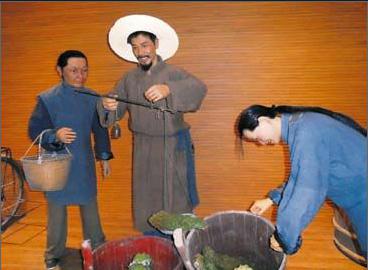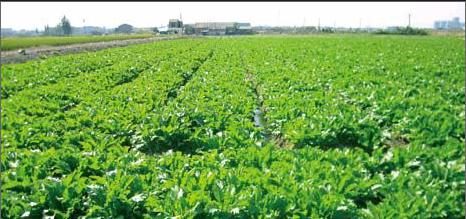嗨!咸菜也有博物馆
沈小宝



2013年10月29日,宁波东乡鄞县大道东吴段68号又一家博物馆开业了,宁波邱隘咸齑登上了大雅之堂。
咸菜,在宁波人的日常俚语中称为“咸齑”。而制作咸齑的主要原料为雪里蕻,即雪菜,所以这座博物馆就被称为宁波鄞州雪菜博物馆了。
邱隘咸齑是宁波传统的菜肴。宁波自古就有“三天勿吃咸齑汤,脚骨有眼(点)酸汪汪”和“家有咸齑不吃淡饭”等谚语。邱隘咸菜色泽黄亮,有香、嫩、鲜、微酸的特点,能生津开胃,可炒、煮、烤、炖、蒸、生拌、配菜肴、做汤料、作馅子。
而宁波的十大名菜中,以咸齑为佐料的“雪菜大汤黄鱼”位于魁首。
邱隘咸齑始于何时已难查证,然宁波地区民间栽培、腌制雪菜历史悠久众所周知。现有史料记载雪菜最早见于明末诗人、鄞州人屠本畯(1573-1620)所著的《野菜笺》,书中记载“四明有菜名雪里壅(蕻)……诸菜冻欲死,此菜青青蕻尤美。 ”清人汪濒在他所著的《广群芳谱》中写道:“四明有菜,名雪里蕻。雪深诸菜冻损,此菜独青。”清光绪《鄞县志》中李邺嗣的《鄮东竹枝词》中也有“纵然金菜琅蔬好,不及吾乡雪里蕻”之句。
另外,在元代王实甫所著的《西厢记》画传第五本第三折中有“齑盐日月不嫌贫”之名,齑盐,即腌菜和盐。明代陈汝的《金莲记》中第二十七出记道,“风雨潇条,衡门替留黄齑白饭度春秋”。咸齑色黄,所以又叫黄齑。南宋诗人陆游更是为此作了一首《咸齑十韵》。
资料反映,20世纪30年代,鄞县咸齑笋的销售遍及宁波东、南、西乡的29个市场,有61家鲜咸货店在经营,这还不包括农民自产自销,在市场设摊经营,以及销往江北、奉化、定海等地的货物。
另据史料记载,邱隘邱一村的周江岸自然村内,民国时期有个“万隆老板”,雇工成批种植雪里蕻,一年两季边割边腌,不断投放市场。其七石缸腌制的方法,人称“压烂泥”。
由于特殊的土质,邱隘咸菜味道鲜美,广受人们欢迎,盛名远播。邱隘咸菜还曾销售到菲律宾、新加坡与马来西亚等地。
2005年4月,邱隘雪菜成功获得了国家质检总局的原产地标记注册,并获颁原产地标记认证证书。
2008年6月,邱隘咸齑被列入宁波市第二批非物质文化遗产名录。
据宁波机场航空食品公司有关负责人介绍,邱隘雪菜作为宁波特色食品的代表,进入了东航、国航、南航以及首都机场、浦东机场、杭州萧山机场等30多家航空公司、机场的航班配菜单。不仅如此,邱隘雪菜近日还进入了国际航班,如国航、东航飞往法国巴黎、意大利罗马、澳大利亚悉尼的国际航班。
如此不凡的邱隘咸齑当然有建博物馆的需要了。长期从事咸齑生产的宁波引发绿色食品有限公司的董事长乐海康,在成为邱隘咸齑腌制技艺的非遗传承人后,经过三年时间的筹划,终于建成了这家民营博物馆。
鄞州雪菜博物馆占地35000平方米,展馆分A、B馆。A馆是一栋五开间、两厢房带天井的清末时期的古建院落,内有七石缸、小饭桶、煤油炉等腌制和烹饪雪菜时用到的炊具物件,也有各种青花、红花瓷碗,或精美,或古雅。分为“历史演绎”、“雪菜栽培”、“腌制加工”、“美食烹调”、“回味无穷”等7个部分,500多件实物与大量墙壁画,全面反映了列入宁波市非遗项目的“雪菜腌制技艺”。
而B馆内除无菌室、干燥室、微生物室、仪器室、天平室、理化室等外,可以通过“观看走廊”,看到全身防护到位的工人在无菌生产车间的操作,以及雪菜的再加工与包装生产流水线的整个运转过程。
邱隘咸齑生产从昔日的大缸腌制、提桶小卖,到现在的工厂化生产、流水线作业,以及鄞州久远的雪菜生产历史,在建成开放的雪菜博物馆里都得到了一一呈现。
在宁波各地村落及外地区也有雪里
《广群芳谱》记载:“四明有菜,名雪里蕻。”图为宁波邱隘雪里蕻菜基地。
This is a large vegetable farm in Qiuga where xuelihong grows.
蕻种植与咸齑腌制,为何邱隘咸齑声誉独佳?据认为邱隘咸齑有三个特点:一是菜梗多菜叶少,吃起来有味道;二是嚼不出渣,很嫩;三是鲜中带酸,爽口。那些有经验的邱隘老菜农则颇有见地,认为种
CULTURE文化时空
植原料菜与制作雪菜技术的传承、把握是邱隘咸齑长销不衰、热销国内外市场的关键。
所有这些,在鄞州雪菜博物馆内均有直观、形象、详尽的展示。□
Yinzhou Pickles Museum
By Shen Xiaobao
October 29, 2013 saw the opening of a very special museum at the Dongwu section of the Yinxian Avenue in Dongxiang, Ningbo. Called Yinzhou Pickles Museum, it celebrates the special role pickled cabbage plays in the culinary tradition of Ningbo and brings the reputation of Qiuga ‘xianji, a signature Ning-bo delicacy, to a new high.
Colloquially called ‘xianji in the Ningbo local dialect, this Ningbo-style treat con-stitutes a very important part in the dietary tradition of Ningbo people, as described in many proverbs such as “After three days without the nourishments from a ‘xianji soup, one feels feeble on the feet”. The ‘xianj made in Qiuga, a small town in Ningbo, is reputed for its radiant color and luster and tender texture, tasting slightly sour and ideal for whetting the appetite. Ningbo ‘xianji can be fried, steamed, roasted, or sautéed; or served cold and dressed with sauce; or used as seasonings and fillings for making succu-lent dumplings. The magic power of ‘xianji also contributes to the reputation of Braised
今日现代化全封闭的无菌雪菜制作车间
The modern aseptic workshop shows how vegetable is being pickled.
Croaker Soup with Pickles, one of the most-loved ten Ningbo dishes.
When the people in Qiuga created the del-icacy is unknown, but Ningbo people have long been known for cultivating a special cabbage locally called ‘xuelihong and mak-ing pickles out of its crunchy, cold-resistant leaves and stems. This culinary tradition dates back in the Ming Dynasty (1368-1644), as recorded in a book by the poet Tu Benjun (1573-1620). Wang Bin, living in the Qing (1644-1911), wrote in his Flowering Plants that “no other vegetables grown in the Sim-ing Mountain area (in todays Ningbo) can survive the severity of winter cold like ‘xue-lihong”.
The obsession of Ningbo people with the
雪菜博物馆中展示的雪菜腌制技艺彩塑。
This small set of sculpture demonstrates how xuelihong is pickled in ancient times.
delicacy is also documented in timeless Ro-mance of the Western Chamber by the play-wright Wang Shifu of Yuan Dynasty (1279-1368) and in Golden Lotus by Chen Ru of the Ming Dynasty. The poet Lu You of the Southern Song (1127-1279) loved the deli-
cacy so much that he glorified it in a poem.
Historical records show Ningbo ‘xianji was sold in 61 shops in 29 markets all over Ningbo in the 1930s, not including peddlers across Ningbo and dealers beyond Ningbo. The written history of Ningbo also includes the story of a legendary ‘xuelihong tycoon living in a village in ancient Qiuga in the Republican Period of China (1911-1949). Known as the ‘Wanlong boss, the man hired a band of farmers to grow and harvest ‘xue-lihong to meet the demand of the Ningbo ‘xianji market. Legend has it that the secret behind the mans success was the special
quality of the soil in his farm and his special
marinating method that produced extremely tasty pickles. During its heyday, the Qiuga pickles made forays into the markets in the Philippines, Singapore and Malaysia.
Qiuga Pickles won the PGI (Protected Geographical Indication) certificate issued by the China National Bureau of Quality In-spection in April, 2005. In June, 2008, Qiuga ‘xianji was listed in the 2nd Ningbo Intangi-ble Cultural Heritages Directory.
Representing the Ningbo culinary tradition, Qiuga Pickles has also found its way into the menus of more than 30 airlines including the China Eastern Airlines, Air China, China Southern Airlines, and a dozen airports such as the Beijing Capital International Airport, Shanghai Pudong International Airport and Hangzhou Xiaoshan International Airport. Qiuga Pickles is also served by a growing number of international flights linking China with Paris, Rome and Sydney.
The privately-run museum is the brain-child of Le Haikang, president of Ningbo Yinfa Green Food, a leading business in making and marketing Ningbo-style pickles. Preparation and construction of the museum took three years to complete.
Covering about an area of 35,000 square meters and set in a Qing-style courtyard compound, the museum encompasses two exhibition halls that chart the path of evolu-tion of this ancient culinary art. The 500-plus artifacts and kitchenware models on display, complete with plenty of drawings on the walls, make you feel like time traveling into the lesser-known culinary pride of ancient Ningbo.
The B Hall of the museum serves for more scientific enlightenment purposes, offering visitors a glimpse of the entire processing flow in making Ningbo Pickles in modern times. The fundamental contributor to the unfailing reputation of Qiuga ‘xianji is the time-tested cultivation and elaborate processing artistry, as illustrated beautifully and convincingly in the Yinzhou Pickles Museum.
——雪里蕻

